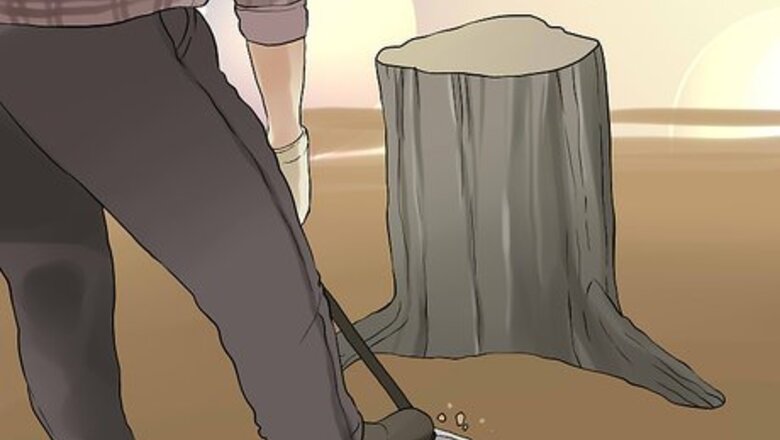
views
- Break up the surface of the soil with an aeration tool. Give the aerated soil a few days to dry out.
- Spread thin layers of gravel and topsoil over the area. Use a shovel or rake to work the amendments down to a depth of 8–9 in (20–23 cm).
- Spread a 2 in (5.1 cm) layer of lime over the soil's surface and wait 1-2 hours. Then, work the lime into the soil to a depth of 6 in (15 cm).[1]
Aerating the Soil
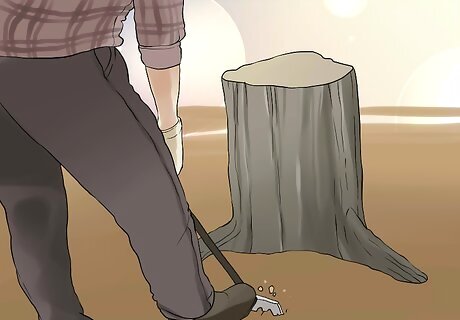
Remove large pieces of debris from the surface of the soil. Go around the area you want to dry and pick up or relocate any rocks, brush, or other ground cover you find sitting on top of the dirt. Clearing away these materials will improve the site’s exposure to air and sunlight, both of which have a natural drying effect on wet soil. It’s especially important to do away with absorbent plant matter. Things like dead leaves, old mulch, and decaying plant stalks have a tendency to hold water, which will just keep your soil soggy. If you don’t clear your work site first, there’s also a risk that you could inadvertently work the debris down into the soil as you turn it, making the problem worse. You can enhance air circulation and access to sunlight even further by cutting back sources of deep shade, such as overgrown shrubs and high branches with thick foliage.
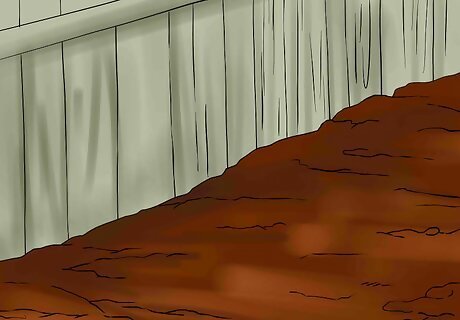
Allow standing water to dry naturally. Aeration will only help dry out your dirt if it isn’t totally saturated. If there’s visible puddling or pooling on the surface, you’ll either need to give the excess moisture time to disappear on its own or resort to a different, more immediate method, such as adding organic drying amendments or lime. You’ll know your soil is ready to aerate once it’s firm to the touch. It can still be wet, but it shouldn’t be so soft that it loses its shape easily. As mentioned, proper exposure to sunlight and air is key to drying out soggy soil quickly. For this reason, it’s best to plan your project for a clear, dry stretch where no further precipitation is expected.
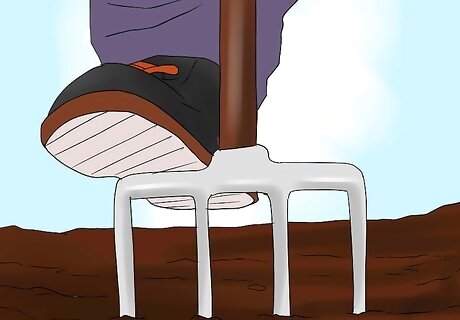
Choose an aeration tool that’s appropriate for the size of your work site. A basic step aerator will work best for small yards and isolated patches of dirt. Long-pronged gardening forks, spike rakes, and strap-on aeration shoes are another useful option. Each of these tools is inexpensive, intuitive, and easy to clean and maintain. If you need to cover more ground, it may be worth it to invest in a manual or motorized rotary aeration machine.Tip: There are even tow-style aerators that you can hitch to the back of a lawn tractor or similar vehicle to turn large patches of soil with minimal time and effort.
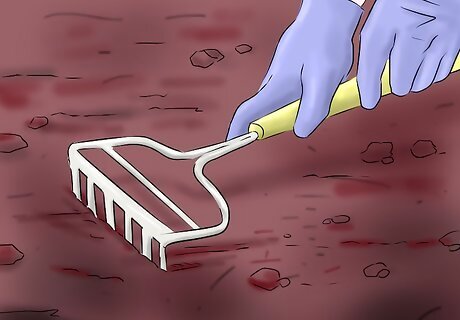
Break up the surface of the soil with your aeration tool. Start at one end of the site and work your way across to the opposite end. Then, turn and go back in the opposite direction, using the prongs of your tool to churn up a fresh patch of untouched soil. Continue in this way until you’ve turned the entire area you want to dry. As you work, the prongs of your aerator will open up lots of little holes in the dirt, allowing more air and sunlight to get in. To use a step aerator, place the prongs against the ground at a 90-degree angle and place your full weight on the head of the tool with one foot to plunge it into the dirt. When using a rake or fork, thrust the prongs into the ground like a spear, then rock the long handle back and forth to loosen the soil. If you’ve opted for a pair of aeration shoes, simply strap them to your feet and walk back and forth across your work site. With this method, you’ll get a little exercise as an added bonus! Operating an aerator machine is usually as easy as pushing it across your work surface like a lawn mower, but be sure to consult the manufacturer's instructions to ensure that you’re using the tool safely and effectively.

Keep the aerated soil clear for the next few days. As soon as you’re finished, collect any lingering debris that your aerator uncovered. Afterwards, make an effort to keep rocks, fallen branches, deteriorating plant matter and other materials picked up while the elements do their thing. As long as the weather stays dry, your soil should be workable within about a week’s time. Removing large clumps of loosened dirt can give the soil more room to expand, which in turn will improve its ability to drain more completely.
Adding Drying Amendments to Growing Soil
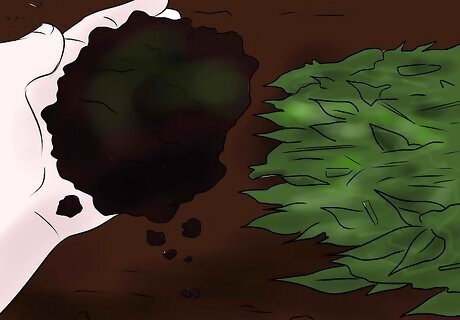
Clear away any possible obstructions that might make it harder to work. Start by raking up scattered brush, leaves, old mulch, and any other dense or absorbent debris. These materials can block air and sunlight from entering the dirt below. As a result, your soil will stay untouched by natural drying processes and remain wet longer. Failing to remove unwanted debris could allow it to find its way into the soil once you add your desired amendments, leaving the soil more waterlogged than before.
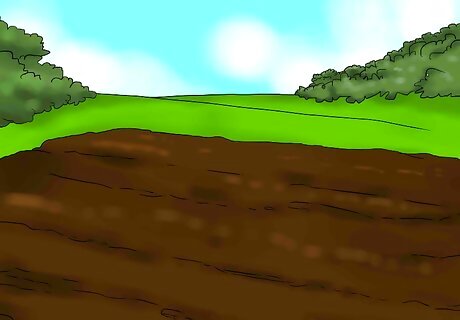
Let the dirt dry as much as possible overnight. After clearing your work site, leave it to sit undisturbed for around 8-12 hours. This will give the surrounding air and sunlight a little time to work their magic on the soil before you begin improving it. There’s no need to wait until it’s completely dry, as this would basically defeat the purpose—just make sure any standing water present has begun to recede. Moisture adds considerable weight to soil, so you’ll have a much easier time working your amendments into the dirt when it’s partially dry. If time is of the essence, it’s alright to begin amending your soil while it is still somewhat soggy. Just be aware that you’ll need to use a lot more elbow grease.
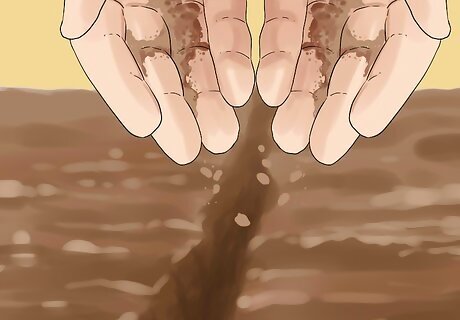
Spread 2–3 inches (5.1–7.6 cm) of gravel over the surface of the soil. Pour one or more bags of fine pea gravel over your work site and use a shovel or rake to disperse it to an even thickness. Working a small amount of gravel into the soil will create some non-absorbent space between the individual particles, letting more air in and minimizing the amount of water that the soil retains. You’ll find pea gravel in various sizes at any gardening store, or in the lawn and garden aisle of your local home improvement center. You also have the option of using sand rather than gravel, provided you’re working with a non-clay soil type. Introducing sand to wet clay can cause it to harden like concrete.
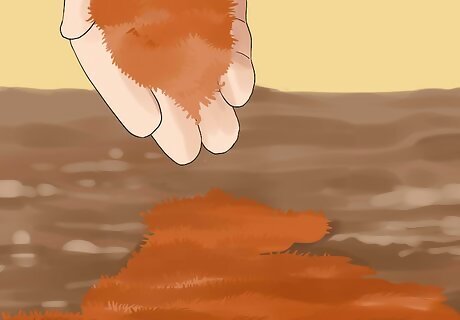
Apply a 2–3 in (5.1–7.6 cm) layer of your organic amendment of choice. Shovel some well-balanced topsoil, compost, humus, or another type of nutrient-dense material directly on top of the gravel. Distribute the material evenly over your work site. You’re now ready to begin mixing the two layers of amendments into the soil. When you add gravel or sand to dirt, you increase the amount of space occupied by non-nutritive components. Your organic amendments will offset this effect by boosting the overall nutrient content of the soil. It’s okay to skip this step if you don’t plan on growing anything in the dirt you’re drying.Tip: A good rule of thumb when working with clay soils is to use roughly 1 cubic yard (0.8 cubic meters) of amendment material for every 100 square feet (9.3 m) of ground. You can get away with using a slightly lower ratio on naturally drier types of soil.
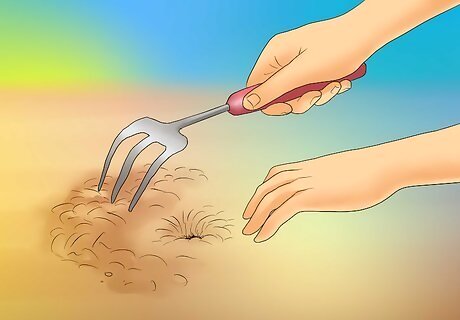
Mix the amendments into the soil with a shovel, rake, or hoe. Use your implement to thoroughly churn the soil over the area you want to dry. As you do, your amendment materials will become incorporated into the wet soil. For best results, aim to work the amendments down to a depth of at least 8–9 inches (20–23 cm), and make sure there are no dense pockets or clusters left behind. Once you’ve amended the wet soil, any water remaining in the upper reaches should drain away faster than usual. You’ll likely have fewer problems with moisture retention for a few weeks or months afterwards.
Speed-Treating Building Sites with Lime
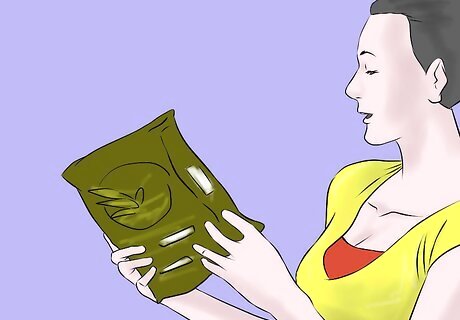
Pick up one or more bags of quicklime or hydrated lime. There are several varieties of agricultural lime, each with its own unique chemical makeup and practical application. For the purpose of drying out saturated soil, your best bet will be to use either quicklime or hydrated lime. Both of these products are available at most major gardening stores and home improvement centers. The supplement known as “quicklime” is actually calcium oxide, while hydrated lime is more accurately known as calcium hydroxide. Both products serve the same function, but quicklime is generally the speedier of the two products. Avoid using standard agricultural lime. This type of lime is simply pulverized limestone, so it won’t be any more effective than drying amendments like gravel or sand.
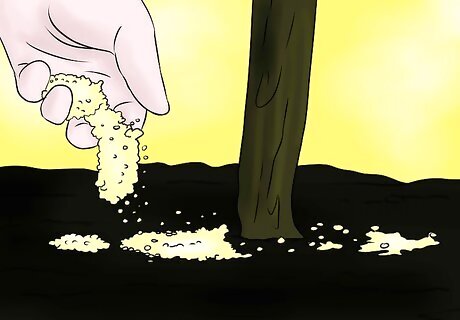
Spread a minimum of 2 inches (5.1 cm) of lime over the surface of the soil. You can either use a shovel to distribute the lime or apply it exactly where you need it by hand. If you’re dealing with a large, open area, such as a cleared construction site, it may help to use a push spreader or pneumatic bulk truck. Cover each area you want to dry completely. Wear gardening gloves, a face mask, and a long-sleeved shirt to protect your skin and airways from irritation caused by lime. Try to make sure that the lime is an even thickness over your entire work site. If necessary, you can pile on additional lime in spots with standing water or particularly muddy soil.

Let the lime sit for 1-2 hours before continuing. During this time, the lime will begin to evaporate excess surface water. This gives it a major advantage over slower drying methods like aeration and amendment..
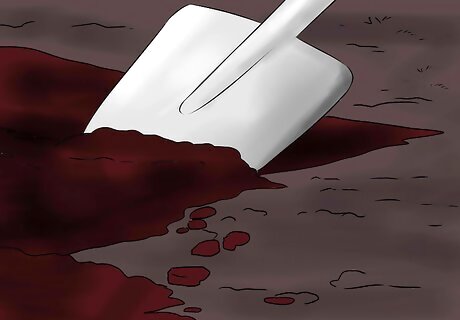
Use a shovel, rake, or hoe to work the lime into the soil. Chop, turn, and dig into the damp dirt to break it up and incorporate the particles of lime still sitting on top. Try to mix the lime to a depth of at least 6 inches (15 cm). The deeper you can get it, the faster and more thoroughly it will dry out your soil. It may be necessary to work the lime as deep as 10–12 inches (25–30 cm) below the surface of the dirt if your work site is completely saturated. You should be able to tell a significant difference in the moisture level of your soil within roughly an hour of treatment.Warning: Keep in mind that adding lime to your soil will raise its pH level, making it more alkaline. This could have a negative impact on growing conditions if you intend to use your work site for raising plants or edible crops.
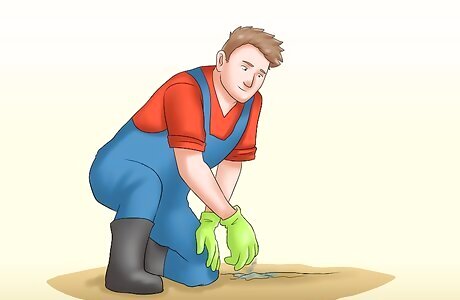
Compact the soil if you’re going to be building on it. Go over the entire surface with a lawn roller or hand tamper, pressing down the treated dirt until it feels firm. In addition to making your work site more structurally stable, compaction will also help to hold the buried lime in place. Because of this, the soil should remain relatively dry, even after heavy rainfall. Walking back and forth over small patches of dirt will also have the same effect without the need to use any additional equipment. Compacting large expanses efficiently may require you to use an industrial rolling device, such as a sheep’s foot or flat wheel roller.



















Comments
0 comment